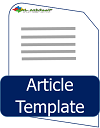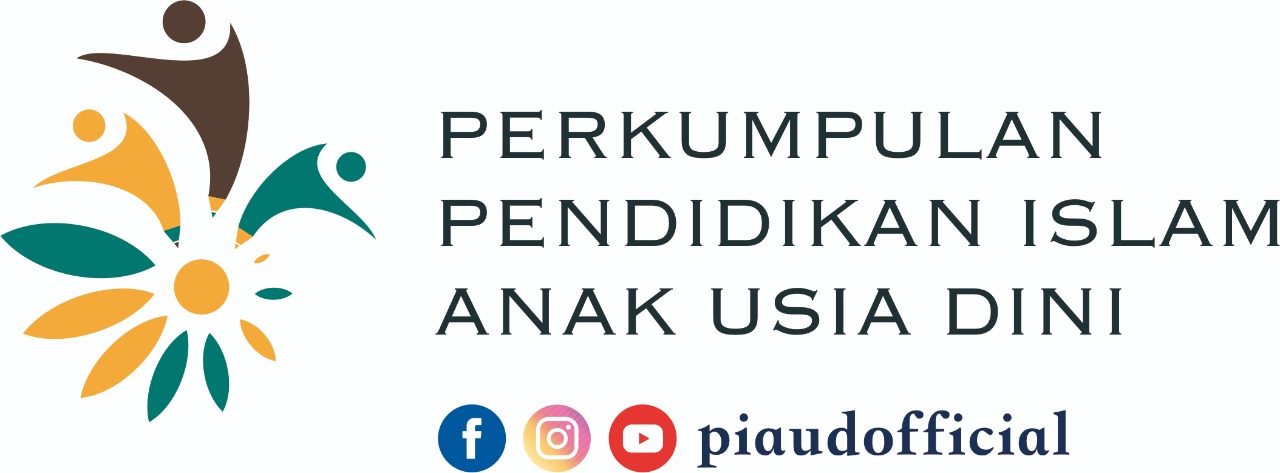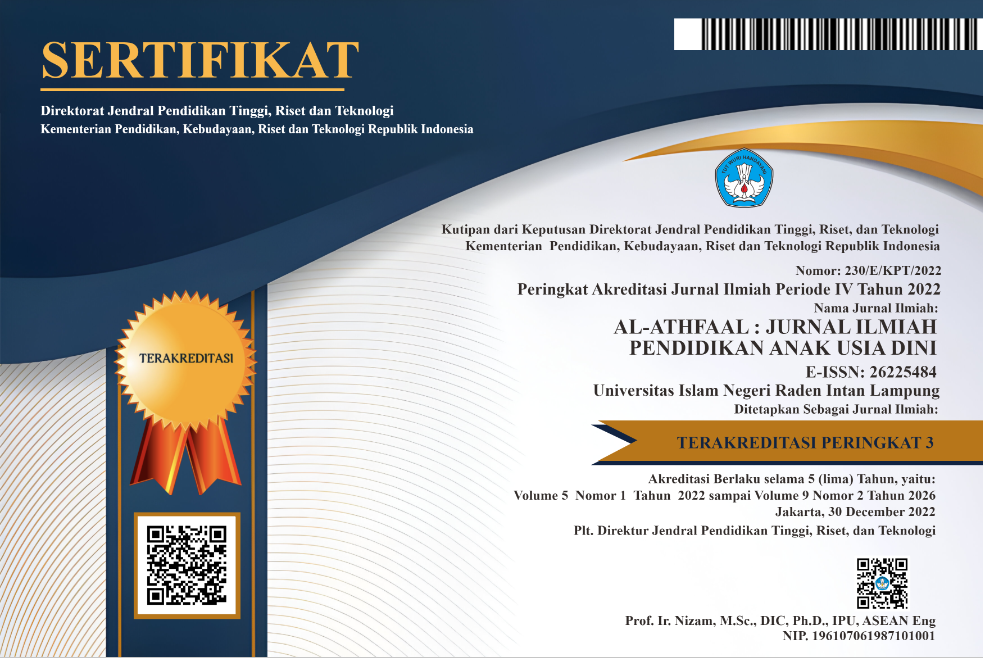Leveraging visual media to improve articulation skills in children with hearing impairments
Abstract
Background: Early childhood is a critical period for language and communication development. Deaf children often face significant challenges in acquiring articulation skills due to hearing impairments, which impact their ability to communicate effectively. Despite various interventions, there remains a need for effective, evidence-based strategies to support these skills.
Aim: This study aims to evaluate the effectiveness of picture media in improving articulation skills in children with hearing impairments. By focusing on articulation rather than broader language skills, this research addresses a gap in existing literature.
Method: A qualitative approach was employed, involving observations, interviews, and documentation to collect data over six months. The study analyzed changes in articulation skills in a deaf child before and after interventions using picture media. Instruments included standardized articulation tests and feedback from parents and teachers.
Result: Findings reveal that picture media significantly enhance articulation skills, enabling children to associate sounds with visual cues effectively. Specific improvements were observed in the pronunciation of vowels and consonants, with gradual progress in constructing syllables and words. Unlike prior studies that primarily explore vocabulary development or general communication in deaf children, this research uniquely focuses on the direct impact of picture media on articulation skills. The study offers evidence-based insights for developing targeted educational interventions for children with hearing impairments.
Conclusion: This study confirms the importance of using visual media, especially pictures, in the learning of children with hearing loss. This approach is not only effective in improving articulation skills but also supports children's optimal communication potential. Thus, picture media can be an important tool in inclusive education for deaf children.Keywords
Full Text:
PDFReferences
Adesina, O. O., Adesina, O. A., Adelopo, I., & Afrifa, G. A. (2023). Managing group work: the impact of peer assessment on student engagement. Accounting Education, 32(1). https://doi.org/10.1080/09639284.2022.2034023
Alfitri, Riski, Mega Iswari, & Kasiyati, Kasiyati. (2018). Meningkatkan pembendaharaan kata melalui media kata bergambar bagi anak tunarungu. Jurnal pendidikan kebutuhan khusus, 2(1), 40-45. https://doi.org/10.24036/jpkk/vol2-iss1/96
Azzam Khan, M. (2022). Effectiveness of early intervention on academic achievement of Hearing-Impaired children. Journal of applied research and multidisciplinary studies, 1(2). https://doi.org/10.32350/jarms.12.03
Choi, K. M., Yoo, S. D., Kim, D. H., Chon, J. M., Lee, S. A., Han, Y. R., Yoo, M. C., Lee, J. J., Yang, M., Choi, Y. H., & Jung, M. J. (2019). Correlations between values of articulation tests and language tests for children with articulation disorder in Korea. Annals of Rehabilitation Medicine, 43(4). https://doi.org/10.5535/arm.2019.43.4.483
Choudhry, A. F., Noor, H. S., Shahid, R., Mukhtar, T., Zahra, S. M., & Butt, G. A. (2021). Academic performance of hearing impaired children who received early intervention. Journal of pharmaceutical research international. https://doi.org/10.9734/jpri/2021/v33i57A33991
Czap, L., Pintér, J. M., & Baksa-Varga, E. (2019). Features and results of a speech improvement experiment on hard of hearing children. Speech Communication, 106, 7–20. https://doi.org/10.1016/j.specom.2018.11.003
Dall’asen, T., & Pieczkowski, T. M. Z. (2022). Learning sign language by deaf children. Revista brasileira de educacao especial, 28. https://doi.org/10.1590/1980-54702022v28e0153
Deocampo, J. A., Smith, G. N. L., Kronenberger, W. G., Pisoni, D. B., & Conway, C. M. (2018). The role of statistical learning in understanding and treating spoken language outcomes in deaf children with cochlear implants. Language, speech, and hearing services in schools, 49(3S), 723–739. https://doi.org/10.1044/2018_LSHSS-STLT1-17-0138
Garvis, S., Phillipson, S., Harju-Luukkainen, H., & Sadownik, A. R. (2021). Parental engagement and early childhood education around the world. In parental engagement and early childhood education around the world. https://doi.org/10.4324/9780367823917
Gifford, R. H. (2020). Bilateral cochlear implants or bimodal hearing for children with bilateral sensorineural hearing loss. In current otorhinolaryngology reports (vol. 8, issue 4). https://doi.org/10.1007/s40136-020-00314-6
Gordon, K., Henkin, Y., & Kral, A. (2015). Asymmetric hearing during development: The aural preference syndrome and treatment options. Pediatrics, 136(1). https://doi.org/10.1542/peds.2014-3520
Hall, M. L., Hall, W. C., & Caselli, N. K. (2019a). Deaf children need language, not (just) speech. First Language, 39(4). https://doi.org/10.1177/0142723719834102
Hall, M. L., Hall, W. C., & Caselli, N. K. (2019b). Deaf children need language, not (just) speech. First Language, 39(4), 367–395. https://doi.org/10.1177/0142723719834102
Jabar, S. A., & Ahmad, A. C. (2018). The design of multimedia interactive courseware for teaching reading to hearing impaired students. International journal of academic research in progressive education and development, 7(4). https://doi.org/10.6007/IJARPED/v7-i4/4849
Kadir, R. (2021). Peningkatan penguasaan kosakata anak tunarungu melalui media gambar pada siswa kelas iv di slb negeri kota gorontalo. Aksara: jurnal ilmu pendidikan nonformal , 7(3), 1185-1192. https://doi.org/10.37905/aksara.7.3.1185-1192.2021
Lieu, J. E. C., Kenna, M., Anne, S., & Davidson, L. (2020). Hearing loss in children: a review. In jama - journal of the american medical association (Vol. 324, Issue 21). https://doi.org/10.1001/jama.2020.17647
Maulana, Andre. (2021). Pemanfaatan media gambar dalam pembelajaran anak autis di SLBN Praya tahun pelajaran 2020/2021. UIN Mataram.
Meinzen-Derr, J., Wiley, S., Grove, W., Altaye, M., Gaffney, M., Satterfield-Nash, A., Folger, A. T., Peacock, G., & Boyle, C. (2020a). Kindergarten readiness in children who are deaf or hard of hearing who received early intervention. Pediatrics, 146(4). https://doi.org/10.1542/peds.2020-010611
Mutiara, I. Mara. (2013). Penggunaan media komunikasi visual dalam meningkatkan bahasa reseptif anak tunarungu: penelitian eksperimen dengan desain single subject research pada anak tunarungu kelas viii slb-b sukapura . Universitas pendidikan indonesia.
Naz, A., Shabnum Noor, H., Hussain, A., Adil Bukhari, S., Pervaiz, N., & Inam, I. (2023). Comparison of traditional articulation therapy and picture articulation test in children with articulation disorders. Journal of health and rehabilitation research, 3(2). https://doi.org/10.61919/jhrr.v3i2.139
Nur Yanah. (2024). Meningkatkan potensi pendidikan anak berkebutuhan khusus dengan manajemen kurikulum slb terpadu di slb negeri 01 kota blitar. Pragmatik : jurnal rumpun ilmu bahasa dan pendidikan , 2(1), 239–246. https://doi.org/10.61132/pragmatik.v2i1.364
Ogino, M. (2021). A developmental checklist for early detection of children with special needs. The japanese journal of special education, 58(4). https://doi.org/10.6033/tokkyou.58.257
Pimperton, H., & Kennedy, C. R. (2012). The impact of early identification of permanent childhood hearing impairment on speech and language outcomes. In Archives of Disease in Childhood (Vol. 97, Issue 7). https://doi.org/10.1136/archdischild-2011-301501
Ridgeway, S. M. (2021). The mental wellbeing of Deaf sign language users. In Clinical Psychology Forum (Issue 348). https://doi.org/10.53841/bpscpf.2021.1.348.45
Rony, Md. A. H., Fatema, K., Raiaan, M. A. K., Hassan, Md. M., Azam, S., Karim, A., Jonkman, M., Beissbarth, J., Boer, F. De, Islam, S. M. S., & Leach, A. (2024). Artificial intelligence-driven advancements in otitis media diagnosis: a systematic review. Ieee access, 12, 99282–99307. https://doi.org/10.1109/ACCESS.2024.3428700
Sahli, A. S. (2019). Age at onset of training in children with hearing and speech disorders and the analysis of related factors in Turkey. Italian Journal of Pediatrics, 45(1). https://doi.org/10.1186/s13052-019-0723-x
Saptari, W. T., Susetyo, B., & Tarsidi, I. (2022). Improving the articulation ability of children with hearing impairment using role playing method. Journal of icsar, 6(2), 258. https://doi.org/10.17977/um005v6i22022p258
Sari, N., & Zarkasih Putro, K. (2021). Assistance and learning strategies for deaf children. Joyced: journal of early childhood education, 1(1). https://doi.org/10.14421/joyced.2021.11-05
Shim, H.-J., Lee, H.-J., & Seo, C.-W. (2018). The effect of articulation therapy using visual phonics to improve the speech intelligibility and vowel space of children with impaired hearing. Phonetics and Speech Sciences, 10(2). https://doi.org/10.13064/KSSS.2018.10.2.85
Sugiarti, S. (2015). Upaya meningkatkan kosa kata anak tunarungu melalui media variasi gambar pada siswa kelas v/b di slb negeri surakarta. Prosiding Seminar Nasional Pendidikan, 1(November).
Sutton-Spence, R. (2021). Storytelling in sign language for deaf children. In Storytelling, Special Needs and Disabilities. https://doi.org/10.4324/9781003159087-10
Wisnu, N. T., Tutik, H., & Handayani, T. E. (2021). Early detection instruments for children with special needs. Open Access Macedonian Journal of Medical Sciences, 9. https://doi.org/10.3889/oamjms.2021.7206
Young, G. D., Philpott, D., Butler, E., Maich, K., & Penney, S. C. (2020). Exploring the Impact of Quality Early Childhood Education on Special Education: Can We Prevent Placement in Special Education? Exceptionality Education International, 29(3). https://doi.org/10.5206/eei.v29i3.9384
DOI: http://dx.doi.org/10.24042/al-athfaal.v7i2.24751
Refbacks
- There are currently no refbacks.
Copyright (c) 2024 Al-Athfaal: Jurnal Ilmiah Pendidikan Anak Usia Dini
License URL: https://creativecommons.org/licenses/by-sa/4.0
 Semua publikasi Al-Athfaal: Jurnal Ilmiah Pendidikan Anak Usia Dini [p-ISSN: 2622-5484, e-ISSN: 2622-5182] dilisensikan di bawah Lisensi Internasional Creative Commons Atribusi-BerbagiSerupa 4.0.
Semua publikasi Al-Athfaal: Jurnal Ilmiah Pendidikan Anak Usia Dini [p-ISSN: 2622-5484, e-ISSN: 2622-5182] dilisensikan di bawah Lisensi Internasional Creative Commons Atribusi-BerbagiSerupa 4.0.











